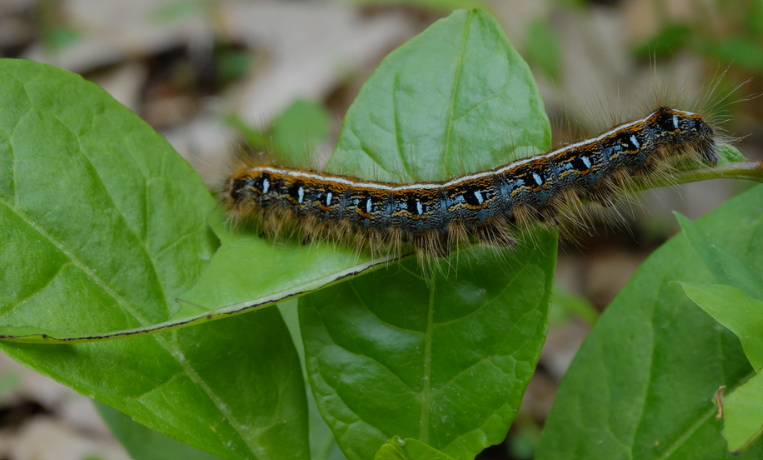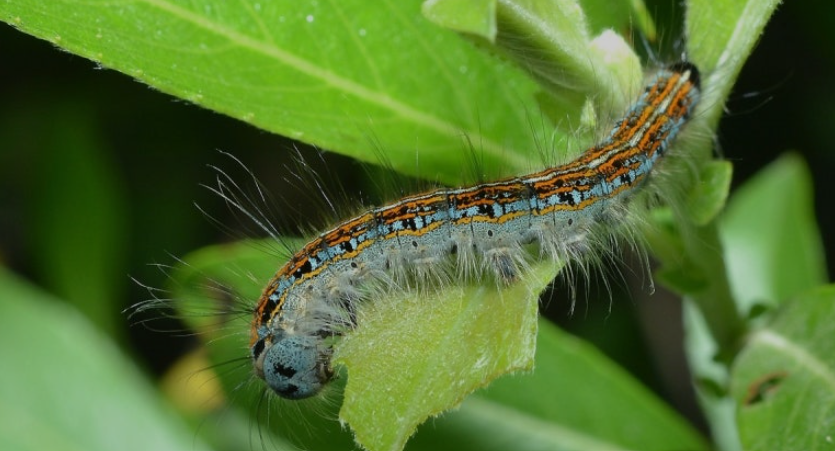
Classification
The Eastern Tent Caterpillar belongs to the family Lasiocampidae, commonly known as the tent moths or lappet moths. Its scientific name is Malacosoma americanum. This family includes moths whose larvae are known for constructing communal silk tents. Like other Lepidoptera, the species undergoes complete metamorphosis, progressing through egg, larva (caterpillar), pupa, and adult stages.
Identifying Characteristics
Eastern Tent Caterpillars are easily recognizable due to their communal silk tents and distinctive appearance. The larvae are hairy with a dark brown to black body and a prominent white stripe running lengthwise down the center of the back. Blue and reddish spots line the sides of their bodies. Early instars are gregarious and often cluster together inside the silk tent, which serves as a protective shelter. As adults, the moths are small and brown, relatively inconspicuous compared to their striking caterpillar stage, with a wingspan of about 1.5 inches.
Distribution, Migration & Habitat
Eastern Tent Caterpillars are native to eastern North America, ranging from southern Canada through the eastern United States. They are non-migratory, remaining within their local habitats throughout their life cycle. These caterpillars are most commonly found in deciduous forests, orchards, and suburban areas, especially where host trees such as cherry, apple, and other members of the Prunus genus are abundant. The silk tents are usually built in the forks of tree branches, providing easy access to foliage for feeding.
Predators & Threats
Despite their communal shelters and hairy bodies, Eastern Tent Caterpillars are preyed upon by birds, parasitic wasps, predatory beetles, and small mammals. The silk tents provide some protection against environmental stress and predators, but they do not make the caterpillars invincible. Human activities, including pesticide use and removal of tents, also pose threats. During outbreaks, these caterpillars can defoliate trees, leading to conflicts with humans managing orchards and ornamental trees.
Lifespan of Adults
Adult Eastern Tent Moths are short-lived, typically surviving only about one to two weeks. Their main purpose is reproduction, and they do not feed, relying entirely on energy reserves accumulated during the larval stage. Females lay eggs in tight masses around tree branches or twigs, ensuring that newly hatched larvae have immediate access to leaves. Once egg-laying is complete, adults die, completing their life cycle.
Host Plants & Diet
The larvae are folivores, feeding primarily on the leaves of deciduous trees. Preferred hosts include cherry (Prunus spp.), apple (Malus spp.), and other members of the rose family (Rosaceae). The caterpillars feed voraciously, often consuming large quantities of foliage and occasionally causing significant defoliation in trees during population outbreaks. Their communal lifestyle allows them to coordinate feeding and maximize growth before pupation.
Lifecycle of Eastern Tent Caterpillar (Malacosoma americanum)

Egg Stage
The life cycle begins in late spring to early summer when adult female moths lay eggs in tight clusters around small branches or twigs of host trees, typically cherry, apple, or other members of the Prunus and Malus genera. The eggs are coated with a protective, shiny, brown substance that shields them from harsh environmental conditions and some predators. These eggs remain dormant through the summer, fall, and winter, overwintering until the following spring when temperatures rise and buds begin to open.
Larval Stage (Caterpillar)
When the host tree begins to leaf out in early spring, the eggs hatch into tiny larvae. The caterpillars are gregarious and immediately start constructing a communal silk tent in the forks of tree branches, which provides shelter from weather and predators. As they grow through successive instars, they develop the distinctive white stripe down the back, along with blue and reddish side spots, and become more hairy.
The caterpillars feed voraciously on leaves surrounding their tents, often leaving noticeable defoliation. This larval stage lasts about four to six weeks, depending on environmental conditions, and is the primary feeding and growth period.
Pupal Stage (Cocoon)
After reaching full size, usually around two inches long, the caterpillars leave the tent to pupate. They spin silken cocoons, often among leaf litter or under bark, where they undergo metamorphosis. Inside the cocoon, the caterpillar’s body reorganizes into the adult moth form. The pupal stage lasts roughly two to three weeks, although timing can vary depending on temperature and climate conditions.
Adult Stage (Moth)
The adult Eastern Tent Moth emerges from the cocoon as a small, brown moth with a wingspan of about 1.5 inches. Adults are short-lived, typically surviving only one to two weeks. They do not feed, relying entirely on energy reserves accumulated during the larval stage.
The primary purpose of adults is reproduction. Males locate females using pheromones, and after mating, females lay eggs on host trees to begin the next generation. Once egg-laying is complete, the adult moths die, completing the species’ annual lifecycle.